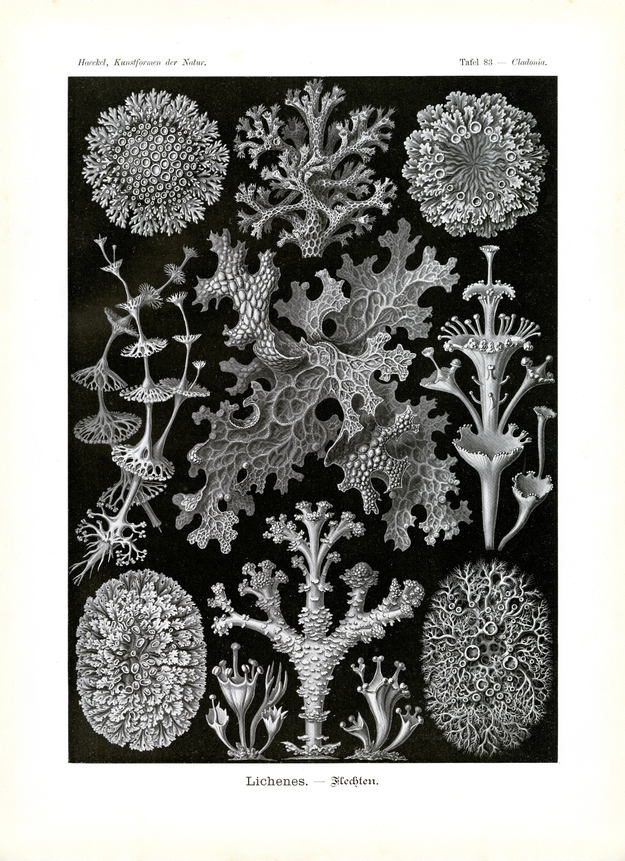Translation of the original German introduction by Ernst Haeckel:
Phylum of Fungi or Mycetes (Pilze); - class of Lichenes (Flechten).
The diversified group of lichens (Lichenes) constitutes one of the most peculiar classes within the plant kingdom, its true nature being clarified only recently. That is to say, each lichen is composed of two distinct plant forms, one belonging to the phylum of real fungi, the other to the division of algae or Algaria (original plants). Fungi (plate 63, 73) are ‘plasmophageous’ plants which are not capable of forming plasma, but rather have to incorporate it from other organisms. Algae, on the other hand, (plate 15, 65) as well as unicellular Algaria (plate 24, 34) are ‘plasmodomeous’ organisms just like most other plants. They have the capacity to produce, out of simple inorganic compounds (water, carbonic acid, nitric acid, ammonia), new living substance or plasma through synthesis (“carbon assimilation”). This biocoenosis, consortium or symbiosis, is particularly beneficial for both cohabiting organisms; green algae secures nutrition and thrift for the fungus and the latter gives protection, habitation and water. Quite similar is the interrelationship of the two ‘life companions’ or symbionts found in plasmophageous Radiolaria and “yellow cells” or Zooxanthella that indwell, as protophytes, the unicellular body of these Protozoa (c.f. plate 51, 71).
The two distinct plant types, plasmodomeous algae (or Algaria) and plasmophageous fungus, are in each lichen most profoundly connated and interdependent, so that the entire lichen body as a consortium appears uniform, taking a very distinct shape; outer appearance as well as internal structure (the regular, hereditary connation of green round algae-cells with colourless thread-like ‘fungus-filaments’) are most peculiar in lichens and distinguish them as a special class of plants. Phylogenetically as well, the numerous species of this class – as specific Consortia – got continuously refined. Proliferation takes place mainly through peculiar ‘dust-germs’ (Soredia); individual green algae cells (Conidia) or groups of such cells are covered by colourless ‘fungus-filaments’ (Hypha) and come off as “symbiontic ‘spawn-buds’” in the shape of ‘dust-grains’ that soon develop into new lichens. Furthermore, lichens propagate by distinct, rounded (usually brown coloured) fruiting bodies (Sporelia) that form spores. These Sporelia are disc- or dish-shaped, resting freely on the surface (Apothecia); they may also be globose or bottle-shaped, sinked into the surface of the Thallus (Perithecia).
Translation by VR Translators Bangalore
We've scanned the original lithography at 1200dpi on the Epson A3 scanner of A3 scanner huren. You can download a 400dpi JPEG here.
